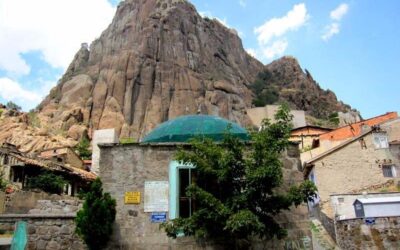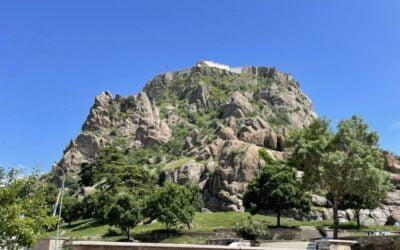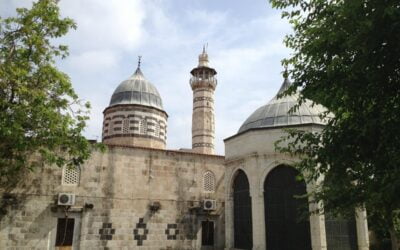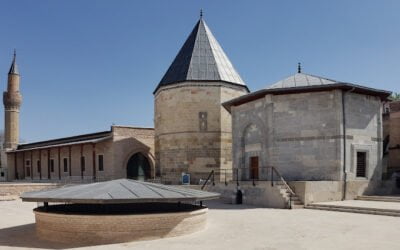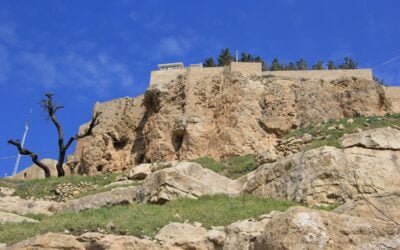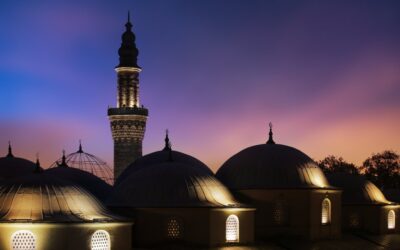Topkapi Palace Museum
- Topkapi Palace Museum served as the main residence and administrative headquarters of the Ottoman sultans. It has many exhibion halls, Treasury section, and Harem.
Bab-us Selam – Gate of Salutation / Middle Gate
- Mehmet the Conqueror built the first stage of the palace shortly after the Conquest in 1453, and lived here until his death in 1481. Subsequent sultans lived in this rarefied environment until the 19th century, when they moved to the ostentatious European-style palaces they built on the shores of the Bosphorus. Before you enter the palace’s Imperial Gate, take a look at the ornate structure in the cobbled square just outside. This is the rococo-style Fountain of Sultan Ahmet III, built in 1728 by the sultan who so favoured tulips. The main ticket office is in the First Court, just before the gate to the Second Court.
- Topkapı Palace was home to all the Ottoman sultans until the reign of Abdulmecid I (1839-1860), a period of nearly four centuries.
First Court
- Pass through the Imperial Gate into the First Court, which is known as the Court of the Janissaries or the Parade Court. On your left first monument is Hagia Irene Museum a Byzantine church of Hagia Eirene, more commonly known as Aya İrini. Third structure is former Imperial Mint (Darphane-i Âmire, constructed in 1727) which named Currency Imperial Ottoman Administration after the Tanzimat Reform.
Second Court
- The Middle Gate led to the palace’s Second Court, used for the business of running the empire. In Ottoman times, only the sultan and the valide sultan (mother of the sultan) were allowed through the Middle Gate on horseback. Everyone else, including the grand vizier, had to dismount.
- The Second Court has a beautiful park-like setting. Unlike typical European palaces, which feature one large building with outlying gardens, Topkapı is a series of pavilions, kitchens, barracks, audience chambers, kiosks and sleeping quarters built around a central enclosure. The great Palace Kitchens on the right (east) as you enter incorporate a dedicated Helvahane (confectionery kitchen). They hold a small portion of Topkapı’s vast collection of Chinese celadon porcelain, valued by the sultans for its beauty but also because it was reputed to change colour if touched by poisoned food.
- On the left (west) side of the Second Court is the ornate Imperial Council Chamber. The council met here to discuss matters of state, and the sultan sometimes eavesdropped through the gold grille high in the wall. The room to the right showcases clocks from the palace collection.
- North of the Imperial Council Chamber is the Outer Treasury, where an impressive collection of Ottoman and European arms and armour is displayed.
Third Court
- The Third Court is entered through the Gate of Felicity. The sultan’s private domain, it was staffed and guarded by white eunuchs. Inside is the Audience Chamber, constructed in the 16th century but refurbished in the 18th century. Important officials and foreign ambassadors were brought to this little kiosk to conduct the high business of state. The sultan, seated on a huge divan, inspected the ambassadors’ gifts and offerings as they were passed through the doorway on the left. Right behind the Audience Chamber is the pretty Library of Ahmet III, built in 1719.
- On the eastern edge of the Third Court is the Dormitory of the Expeditionary Force, which was closed for restoration at the time of research. When it reopens it will house the palace’s rich collection of imperial robes, kaftans and uniforms worked in silver and gold thread. On the other side of the Third Court are the Sacred Safekeeping Rooms. These rooms, sumptuously decorated with İznik tiles, house many relics of the Prophet. When the sultans lived here, the rooms were opened only once a year, for the imperial family to pay homage to the memory of the Prophet on the 15th day of the holy month of Ramazan. Next to the sacred Safekeeping Rooms is the Dormitory of the Privy Chamber, which houses an exhibit of portraits of 36 sultans. The highlight is a wonderful painting of the Enthronement Ceremony of Sultan Selim III (1789) by Konstantin Kapidagli.
Imperial Treasury – “The Topkapı Dagger (17th century)”
- Located on the eastern edge of the Third Court, Topkapı’s Treasury features an incredible collection of objects made from or decorated with gold, silver, rubies, emeralds, jade, pearls and diamonds. The building itself was constructed during Mehmet the Conqueror’s reign in 1460 and was used originally as reception rooms. It was closed for a major restoration when we last visited. When it re-opens, look out for the jewel-encrusted Sword of Süleyman the Magnificent and the extraordinary Throne of Ahmed I (aka Arife Throne), which is inlaid with mother-of-pearl and was designed by Sedefhar Mehmet Ağa, architect of the Blue Mosque. And don’t miss the Treasury’s famous Topkapı Dagger, object of the criminal heist in Jules Dassin’s 1964 film Topkapı. This features three enormous emeralds on the hilt and a watch set into the pommel. Also worth seeking out is the Kasıkçı (Spoonmaker’s) Diamond, a teardrop-shaped 86-carat rock surrounded by dozens of smaller stones that was first worn by Mehmet IV at his accession to the throne in 1648.
Fourth Court – “Spoonmaker’s Diamond”
- Pleasure pavilions occupy the palace’s Fourth Court. These include the Mecidiye Kiosk, which was built by Abdül Mecit (r 1839–61) according to 19th-century European models. Up steps from the Mecidiye Kiosk is the Head Physician’s Pavilion. Interestingly, the head physician was always one of the sultan’s Jewish subjects. On this terrace you will also find the Kiosk of Mustafa Pasha, sometimes called the Sofa Köşkü. During the reign of Ahmet III, the Tulip Garden outside the kiosk was filled with the latest varieties of the flower.
- Up the stairs at the end of the Tulip Garden is the Marble Terrace, a platform with a decorative pool, three pavilions and the whimsical İftariye Kameriyesi, a small structure commissioned by İbrahim I (‘the Crazy’) in 1640 as a picturesque place to break the fast of Ramazan. Murat IV built the Revan Kiosk in 1636 after reclaiming the city of Yerevan (now in Armenia) from Persia. In 1639 he constructed the Baghdad Kiosk, one of the last examples of classical palace architecture, to commemorate his victory over that city. Notice its superb İznik tiles, painted ceiling and mother-of-pearl and tortoiseshell inlay. The small Circumcision Room (Sünnet Odası) was used for the ritual that admits Muslim boys to manhood. Built by İbrahim I in 1640, the outer walls of the chamber are graced by particularly beautiful tile panels.
Facilities & Services & Tips & Rules
- Disabled access is possible but wheelchairs are not available and cobblestone-covered hills might cause problems for handicapped travelers.
- There is no parking facility in the palace place.
- Photography is not allowed inside the museum halls.
- Tickets for children below the age of 6 are free.
- Entrance is free of charge for disabled visitors and one companion who is a first degree relative.
- Audio guides or personal guides are recommended to bring out sophisticated details of the palace.
- Imperial gate security check queues can be long, You can enter the first courtyard from Archaelogy Museum just up steep way via Gülhane Park.
- Smoking (Including Electronic Cigarettes) Is Strictly Prohibited Throughout The Entire Premises Of The Museum To Avoid Potential Fire Incidents And Exposing Other Visitors To Secondhand Smoke.

